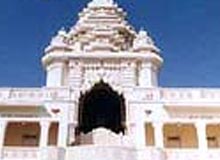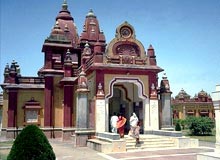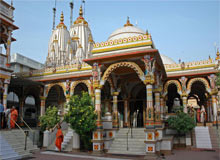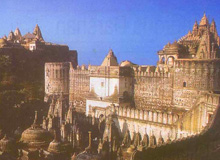Sunday, July 31, 2011
Suraj Mandir Somnath
Saturday, July 30, 2011
Swaminarayan Temple Rajkot
Bhavnath Mahadev Temple
Friday, July 29, 2011
Bhalka Tirth Somnath
Somnath Temple Somnath
Thursday, July 28, 2011
Kumar Pal Temple Palitana
Shri Adishwara Temple Palitana
Wednesday, July 27, 2011
Chaumukh Shrine Palitana
Tuesday, July 26, 2011
St Thomas Church Diu
hurch of St Francis of Assisi Diu
Jain Temple Daman
Monday, July 25, 2011
Church of our Lady of the Sea Daman
Raj Babri Mosque Ahmedabad
Sunday, July 24, 2011
Sidi Bashir Mosque Ahmedabad
Hathee Singh Temple Ahmedabad
Saturday, July 23, 2011
Dwarkanath Temple Dwarka
Rukmini Temple
Friday, July 22, 2011
Swaminarayan Temple
Holy Places in Gujarat
Thursday, July 21, 2011
Jagat Mandir:
| Jagat Mandir: |
| City : Rajkot |
 | Jagat Mandir Built of red stones, it is a beautifully carved temple of Shri Ramkrishna Paramhansa. the presiding deity of Shri Krishna known as Dwarkadhish, is an imposing edifice and a superb architectural monument. Temple is spread in the area of 1800 square feet, the temple consists of a shrine that is supported by 60 pillars of granite and sandstone. On the west side of the temple is the seat of Adi Shankaracharya, the great master of Hindu faith who visited the temple in the seventh century. For the scholars, a wall poster depicting the family tree tracing the lineage to Lord Krishna offers an interesting insight into the great Indian epic of Mahabharat. |
An interesting history surrounds the idol installed at this temple. It is said that, taking pity on his old devotee Badana, who used to traverse the long distance from Dakor to Dwarka, God in the form of an idol went with him to Dakor. This enraged the priests at Dwarka, who chased Badana to retrieve the idol. Badana persuaded the priests to leave the deity in return of gold, where upon the priests agreed to withdraw. By a miracle, the idol became as light as the nose-ring, which was all that the poor widow could offer. But the Lord did not want to disappoint the priests. He therefore granted them a boon that they will find a replica in Dwarka on a particular day. Unable to resist their curiosity, the priests excavated at the suggested site a little too early, and found yet to grow idol, which is now enshrined at Dwarka. |
The present shrine is not likely to be older than the Mughal period. The inscriptions on the pillars and other places do not appear to be older than the 15th century AD. There must have been an older shrine, which was probably destroyed by Mohmud Begada in 1473 AD. The present temple was probably constructed during the period of the great Mughal Emperor, Akbar. |
Kirti Mandir
| Kirti Mandir |
| City : Porbandar |
 | The Kirti Mandir's premises is a three storeyed ancestral house of Gandhiji wherein the exact place where Putlibai, Gandhiji's mother, had given birth to the child Gandhi marked with a 'swastik'. Narrow wooden staircase leads the visitor to upper storey, in particular to Gandhiji's reading-room. |
The adjoining new building, Kirti Mandir, houses a Gandhian library, a prayer hall, a nursery and a steeple decorated with episodes from Gandhiji's life. Behind Kirti Mandir is Navi Khadki, where Kasturba, Gandhiji's wife was born. |
Bala Hanuman Temple
| Bala Hanuman Temple |
| City : Jamnagar |
 | The Bala Hanuman Temple is situated on the southeast side of Ranmal Lake in Jamnagar. since August 1, 1964 there has been a continuous chanting of the invocation 'Shri Ram, Jai Ram, Jai Jai Ram' known as 'Ramdhun', 24 hours a day. This devotion has given the temple a place in the Guinness Book of Records. Early evening is a particularly good time to visit as it's fairly animated then. In fact, this whole area on the southeastern edge of the lake becomes very lively around sunset when people come to promenade, and the usual 'chai' and 'kulfi' stalls set up and ply their trade. |
Wednesday, July 20, 2011
Swaminarayan Temple
| Swaminarayan Temple |
| City : Ahmedabad |
 | Temple is Located near Rani-no-Hazira across Relief Road. The Swaminarayan Temple stands behind huge gates and brightly painted Walls. Forming a delicate contrast to the many hard stone mosques in the city, both the temple and the houses in the courtyard surrounding it are of finely carved wood, with elaborate and intricate patterns typical of the style of the havelis of north and west Gujarat. Surrounding Temple area is total Shopping area. Anyone can get anyting from here. Temple is know for its arts. |
Takhteshwar Temple
| Takhteshwar Temple |
| City : Bhavnagar |
 | Takhteshwar Temple is located on a hill, on a high plinth, near the Takhteshwar railway station on the railway line between Bhavnagar and mahuva. A Temple was built by Maharaja Takhatsihnji. The high shikhara rising above the pillared rectangular mandapa makes it an important landmark. Made of pure marble and constructed in late nineteenth century. The picturesque view from the temple adds to the serenity of the place. It is a beautifull edifice with scenic Environs. This temple provides paqnoramic city view. |
Tuesday, July 19, 2011
Hathee Sing Temple
| Hathee Sing Temple |
| City : Ahmedabad |
 | This is the best known of Ahmedabad's many Rich Jain Temples. It is Built in 1850 AD by Jain Merchant. |
Temple is in pure white marbles. The 52 shrines, each with an image of a Jain Tirthankar in the temple are places to be seen in Ahmedabad. This Jain temple of Ahmedabad was built by Sheth Hathee Singh in 1848 and is dedicated to Dharmanath, the fifteenth Jina or Jain aposite. |
• Kirti Mandir
| • Kirti Mandir |
| City : Baroda |
 | Meaning 'Hall of Fame', it's a memorial for the Gaekwad rulers. Designed in the Hindu style, it is a magnificent stone building with domes, terraces, balconies and a central 'shikhara'. It is decorated with murals by the famous Indian artist, Nandlal Bose. |
Monday, July 18, 2011
Somnath Temple
| Somnath Temple |
| City : Chorwad |
 | Legend has it that the Somnath Temple was originally built out of gold by Somraj, the moon god. Then, it was rebuilt by Ravana in silver and then again by Krishna in wood and yet again by King Bhimdev Solanki in stone in the 10th century. The temple was so rich that it had over 300 musicians, 500 dancing girls and even 300 barbers - just to shave the heads of pilgrims. Mahmud of Ghazni, upon hearing the description of the temple by an Arab traveller by the name Al Biruni, raided the temple in 1024 AD and after looting it, carried away camel loads of jewels and gold. |
Somnath was destroyed six times and rebuilt on every occasion. After the 1706 AD demolition by the Mughal Emperor Aurangzeb, it was rebuilt the seventh time in 1950 AD with the support of Sardar Vallabhbhai Patel. The temple contains one of the twelve sacred Shiva shrines known as 'Jyotirlingas'. |
Gabbar Mandir
| • Gabbar Mandir |
| City : Ahmedabad |
 | Just 5 km away from Ambaji Temple, The famous mountain of Gabbar is situated on the border of States of Gujarat and Rajasthan, near the flow of the origin of the famous Vedic virgin river SARASWATI, on the hills of Arasur in forest , towards south-west side to ancient hills of Arvalli, at the altitude of about 480 meters, at about 1600 feet high from sea level, having at 8.33 sq km (5 sq. miles area ) area as a whole, and it is in fact One of the Fifty One (51) famous Ancient Pauranik Shakti Piths - The Centre of Cosmic Power of India and it is the original holy place of Mata Ambaji, where the piece of the heart of the dead body of Devi Sati fell at the top of this holy hill of Gabbar as per the legend narrated in the "Tantra Chudamani". |
The Mountain or Hill of Gabbar has also a small temple fortified from the western side and there are 999 steps to go up to the mountain and reach this holy temple at the top of Gabbar Hill. A Holy Lamp is constantly burning on this hill temple facing exactly in front of Visa Shree Yantra of Nij Mandir of Mata Shri Arasuri Ambica. |
Sunday, July 17, 2011
• Mahaveer Swami Temple
| • Mahaveer Swami Temple |
| City : Ahmedabad |
 | This temple has a dome. On the open square, there are excellent sculptural carvings of goddesses. in the terrace, pavapuri the place of nirvana of Mahavir is constructed of marble. There are metal idols of the twenty four Tirthankars. There is a silver coated carved fort of Astapadji. There is a bluish cristal idol of Bhagwan Shantinath. A bulb of electricity is not used at all in this temple. The temple is lighted with lamps burnt with coconut oil. The atmosphere is full of joy and peace. |
This temple is very ancient. There is a referene that it belong to a period earlier than the year 1662 of the Vikram era. In the year 1922 of the Vikram era, this temple was rebuilt by Sheth Umabhai Rupchand, a resident of Fatasapole at the expenses of Rs. 50000. The idol of Bhagwan Mahavir belongs to the times of King. Samprati. In the year 1922 of the Vikram era, it was found from the residential place of a muslim Fakir, outside the Jamalpur gate of the Karnavati city. In those days, there was no railway line in India.One could go on a pilgrimage on foot in a sangha. Once a sangha of Palitana was to set out on a pilgrimage. Only the well-to-do could join the sangha. A Jain gentleman often used to go to the Fakir’s place. He wished to go on a pilgrimage but his monetary condition was not good. He was, therefore, feeling uneasy and agonised. Once the Fakir saw him in a pensive mood and asked him the reason for it. He then told the fact. Fakir requested him to be free from worries and asked him to prepare for the pilgrimage. Next day, Fakir took him to the cellar of his house, and showed him the idol. The Fakir always kept a lamp of ghee and and incense - stick burning before the idol. The Fakir bound a bandage round the eyes of the Jain gentleman and said to him, " I shut the celler. Recite the mantra of your dharma and when you hear noise, unite the bandage tied round your eyes." He did so and found himself sitting with his luggage, among the pilgrims at the foot of the the mountain in Palitana. |
Then he returned with the sangha. Then he always bowed his head to the idol. After some time, the Fakir fell ill. Then he requested the Jain gentleman to take away the idol. He was afraid that after his death, his caste - fellows would break the idol. On his reqeust, the idol was installed in this temple. Devotees do not miss to pay obeisance to the idol on the first day of the bright half of the month of Kartak i.e. the new year day, on the 13th day of the bright half of the month of Chaira i.e. the birth Kalyanak day of Bhagawan Mahavir, and on the first day of the bright half of the month of Bhadrapad i.e. the birth - reading day of Bhagawan. They come in a large number. The idol is adorned with rich dress and ornaments. The heirs of this rich merchant are alive. A flag is hoisted on his birth day. |
Surat, Gujarat
Surat, Gujarat
 |
| The East India Company established its first warehouses in Surat in 1612. And it was at Surat that Sir Thomas Roe landed when he came as King James' ambassador to the court of Emperor Jehangir. In Mughal times, Surat was the main port from which pilgrims sailed to Mecca. Surat is known for silks and exquisite brocades and its trade in spices. Surat has been one of the most prosperous of India's cities in the 17th and 18th century. Surat, the city of commerce was an important port that first attracted the Europeans to the riches of India. |
 |
Even today, Surat is a premier industrial city of India. It is a city of riches, of gems and diamonds. Times may have changed but Surat remains and continues to grow. Surat was founded by Parsi refugees in the 12th century, and it emerged as a minor trading post during the 1500s when it was plundered and razed numerous times by the Portuguese. In 1592, after a protracted siege, the town fell to Akbar, under whose patronage, it became one of India's most prosperous mercantile capitals, as well as a key transit point for Muslims heading to Mecca. |
Saturday, July 16, 2011
Rajkot, Gujarat
Rajkot, Gujarat
 |
| Once Rajkot was the capital of the state of Saurashtra. Today, it is best known as the town where Mahatma Gandhi spent the early years of his life when his father was a 'Diwan' or Prime Minister to the king of Saurashtra. Even today, their family home here houses a permanent exhibition of Gandhiji's personal belongings. |
 |
Rajkot has a fine museum and some old colonial architecture.Handicrafts like silver and textiles are a highlight of Rajkot, which has the National Weaving Institute, which is working to promote traditional weaves. Rajkot is one of the most important commercial and industrial cities of Saurashtra. |
The Rajkot city is, situated 246 kms from Ahmedabad.
Porbandar, Gujarat
Porbandar, Gujarat
 |
| Porbandar, situated at the end of Saurashtra is a seaport on the Arabian Sea having pleasant beaches with beach villas. Porbandar is Birthplace of the Father of the Nation, Mahatma Gandhi, Porbandar is an intermediate seaport on the southwest coast of Saurashtra. To commemorate the birth of Gandhiji, a 79 feet high imposing building has been built in an otherwise simple lane of the city where Bapu was born in 1869 AD. It is also known as "White City" because of its white stone construction. Visitors are also attracted to Bharat Mandir, depicting great men and religious preceptors of India, and to the Chowpaty, which offers a beautiful view of the beachfront. Modern villas have come up lately and there is also a small parlour serving refreshments. |
 |
The very name evokes visions of Mahatma Gandhi who was born in this prosperous princely city on October 2, 1869. But the history of Porbandar goes back many centuries to Sudamapuri mentioned in the Hindu epic, Mahabharata, as the home of lord Krishna's friend, Sudama, and almost certainly the Paureliva, mentioned in the 9th century inscriptions at Ghumli. Porbandar is a paradise for bird watchers. Great flocks of flamingoes, both greater and lesser, can be seen at a remarkably close range around the coastal marshes. |
Porbandar is 40 Kms From Rajkot, Gujarat..
Friday, July 15, 2011
Pavagadh, Gujarat
Pavagadh, Gujarat
 |
| the center of attraction for pilgrimage in Gujarat, is Champaner-Pavagadh, which is know as Pavagadh. Pavagadh is situated in the Halol Taluka, 49 kms from Vadodara. In old inscriptions, the name of the hill also appears as 'Pavagadh' or 'Fire-Hill'. It covers about 42 kms in circumference. Pavagadh, rising to a height of 800 metres. Foundation of Champaner has been ascribed to various persons including Champa, a minister of Vanaraja; the Chavda ruler of Gujarat and Champa, a Bhil headman, became a part of the British Raj in the 19th century. In between, many Muslim rulers ruled over the area |
 |
There was a valley where the Pavagadh Hill now stands. On the elevated ground overlooking the valley, lived the famous Rishi Vishvamitra. He owned a cow, Kamdhenu, gifted with speech and an inexhaustible source of milk. Grazing on the brink of the hollow, Kamdhenu one day slipped and being unable to climb the steep sides, she filled the valley with her milk and swam home. Learning what had happened, Rishi Vishvamitra, to prevent another mishap, prayed that the valley be filled up. His prayers were granted by the gods by sending so large a hill that three quarters of it filled up the hollow and the rest standing out of the plains was called Pavagadh, the quarter-hill. |
Pavagadh is 49 Kms From Vadodara, Gujarat. |
Patan, Gujarat
Patan, Gujarat
 |
| The town of Patan founded in 1796 AD is situated on the river Saraswati, about 51 kms from Mehsana and 130 kms from Ahmedabad . Originally known as Anhil-Vad-Pattan. The streets of its older quarters present an interesting look with a mélange of carved balconies, lintels of Muslim havelis, marble domes and the canopies of the over 100 Jain temples. |
 |
Patola silk saree woven in Patan is well know all over the world.The Patan Patola is one of the finest hand-woven textiles produced today. It combines the art of tying and dyeing of the warp and weft threads and their weaving together, when each warp thread is carefully placed against the corresponding colours. Besides Patan, the double Ikat is woven only in Bali in Indonesia. Patan is a beautiful old town with Jain temples and caned wooden houses. Ranaki Vav (step-well) and Sahastralinga Talav or Lake are also interesting places to visit in Patan. |
Patan is 130 Kms From Ahmedabad, Gujarat.
Thursday, July 14, 2011
Palitana, Gujarat
Palitana, Gujarat
 |
| Palitana lies at the foot of the Shatrunjaya Hill, with the Shatrunjaya River flowing to its south. It is 56 kms from Bhavnagar. One of the most famous Jain Temple in Gujarat and also in India. |
 |
The sacred hill rises in a crescendo of magnificient temples numbering 863 in all, soaring in marble splendour to the top of the hill. The temples were built over an impressive span of 900 years with each generation of pilgrims making its contribution to the shrines of Shatrunjaya. The 600-metres climb to Shatrunjaya is usually made on foot. Dolis or lift-chairs are also available. |
Palitana temples are considered to be the most sacred in all the Jain temples. The most important temple is that of the first Terrthankara. Kuwarpal Solanki, a great Jain patron, built the a earliest temple. It has a fabulous collection of jewels. It takes approximatly two hours to cover the 4 kms long ascent. When you are on the top, the Air is clean and the Shetrunjaya River looks glistening like a foil of silver spread on the ground. Pilgrims and even priests are not allowed to stay overnight. Tourists cannot carry any leather item. The Temple town of Palitana has some interesting handicrafts and 2 museums of Jain art - the Stapiya Kala Sangrah and the Shri Vishal Jain Kala Sansthan. |
Air: Nearest airport at Bhavnagar is 62 kms away.
Rail: Palitana is on the Western Railway metre gauge line and is well connected to Ahmedabad , 277 kms. by rail and 215 kms. by road.
Road: State Transport & luxury buses ply regularly.
Rail: Palitana is on the Western Railway metre gauge line and is well connected to Ahmedabad , 277 kms. by rail and 215 kms. by road.
Road: State Transport & luxury buses ply regularly.
Dwarka, Gujarat
Dwarka, Gujarat
 |
| The presiding deity of Shri Krishna known as Dwarkadhish, is an imposing edifice and a superb architectural monument. Temple is spread in the area of 1800 square feet, the temple consists of a shrine that is supported by 60 pillars of granite and sandstone. On the west side of the temple is the seat of Adi Shankaracharya, the great master of Hindu faith who visited the temple in the seventh century. For the scholars, a wall poster depicting the family tree tracing the lineage to Lord Krishna offers an interesting insight into the great Indian epic of Mahabharat. |
 |
An interesting history surrounds the idol installed at this temple. It is said that, taking pity on his old devotee Badana, who used to traverse the long distance from Dakor to Dwarka, God in the form of an idol went with him to Dakor. This enraged the priests at Dwarka, who chased Badana to retrieve the idol. Badana persuaded the priests to leave the deity in return of gold, where upon the priests agreed to withdraw. By a miracle, the idol became as light as the nose-ring, which was all that the poor widow could offer. But the Lord did not want to disappoint the priests. He therefore granted them a boon that they will find a replica in Dwarka on a particular day. Unable to resist their curiosity, the priests excavated at the suggested site a little too early, and found yet to grow idol, which is now enshrined at Dwarka. |
The present shrine is not likely to be older than the Mughal period. The inscriptions on the pillars and other places do not appear to be older than the 15th century AD. There must have been an older shrine, which was probably destroyed by Mohmud Begada in 1473 AD. The present temple was probably constructed during the period of the great Mughal Emperor, Akbar.
Wednesday, July 13, 2011
Diu, Gujarat
Diu, Gujarat
 |
| Island of Diu lies across Ahmedapur-Mandvi., a fine blend of sun, sand and deep blue sea. Diu is situated 125 kms from Junagadh. This beach is known as one of the finest beach in India. Diu Island is situated across the bridge from Ahmedpur-Mandvi. Lying on the offshore of Gujarat mainland, minutes offshore from the mainland of Gujarat, yet has the feel of being like on a Mediterranean Island. |
 |
Diu reflects the Portuguese colonial period architecture like the churches, public buildings, bungalows with pastel shaded walls, truss roofs, terraces, galleries, clean wide roads, neat clean beaches etc. Three Portuguese churches, one out of which has been converted into a museum housing some rare Portuguese artifacts, also dot the island. Another cynosure at Diu is the Fort of Diu, an imposing statement of power. |
Diu Beach is 125 Kms From Junagarh, Gujarat.
Tuesday, July 12, 2011
Chorwad, Gujarat
Chorwad, Gujarat
 |
| Chorwad is a small village where fishing is main occupation. It is a fine place to enjoy views of rocky shores, boat riding and also a base to visit places like Porbandar, Somnath etc. Chorwad is a delightful beach with its resort on the sunny coast of Gujarat. It is 66 kms from Junagadh and 23 kms from the fishing centre of Veraval. It is a holiday resort with an isolated beach and is away from bazaars, crowds etc. |
 |
There is a resort which was previously a palace built by Nawab Saheb Mohabbat Khan as a vacation spot for the hot summer days where he held weddings of his dogs, royal banquets and processions amidst cool breezes from the sea. the pleasant climate attract tourists. The sea is not calm. Chorwad is perfect for long beach walks and a quiet holiday. |
Chorwad is 66kms From Junagadh, Gujarat.
Subscribe to:
Posts (Atom)


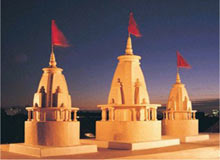
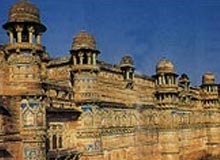 Introduction:
Introduction: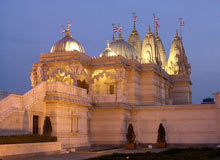

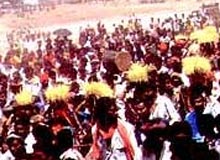 Located at the foot hills of the Girnar Hills, the Bhavnath Mahadev Temple is one of the foremost Holy Places in Junagadh. Nothing much is known about its precise origin but there is no scope of doubt about its historicity. It has stood their since ancient times. Visited by religious minded devotees all along the year, it is however best known for being the venue of the famous Bhavnath Fair.
Located at the foot hills of the Girnar Hills, the Bhavnath Mahadev Temple is one of the foremost Holy Places in Junagadh. Nothing much is known about its precise origin but there is no scope of doubt about its historicity. It has stood their since ancient times. Visited by religious minded devotees all along the year, it is however best known for being the venue of the famous Bhavnath Fair.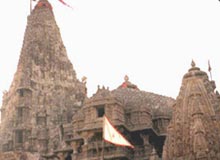 Introduction:
Introduction: 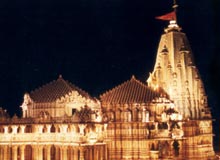
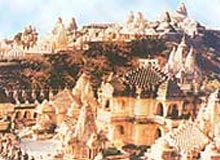 Introduction to Kumar Pal Temple, Palitana
Introduction to Kumar Pal Temple, Palitana 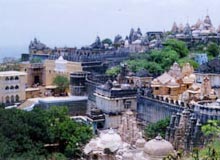 Introduction to Shri Adishwara,Palitana
Introduction to Shri Adishwara,Palitana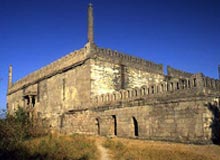 Introduction to Chaumukh Shrine, Palitana
Introduction to Chaumukh Shrine, Palitana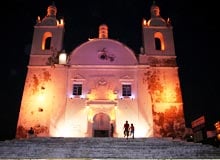
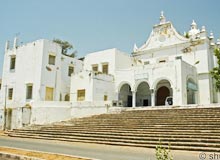
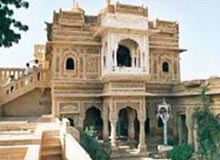
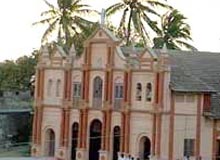
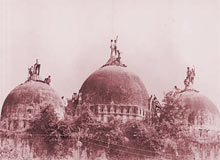 Introduction :
Introduction :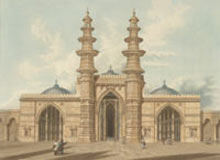 Introduction :
Introduction :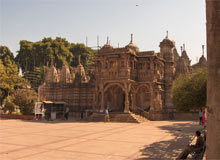 Introduction :
Introduction :